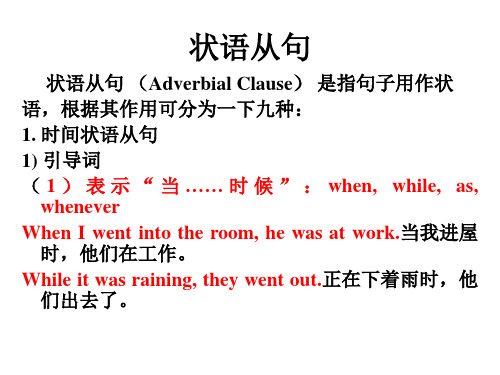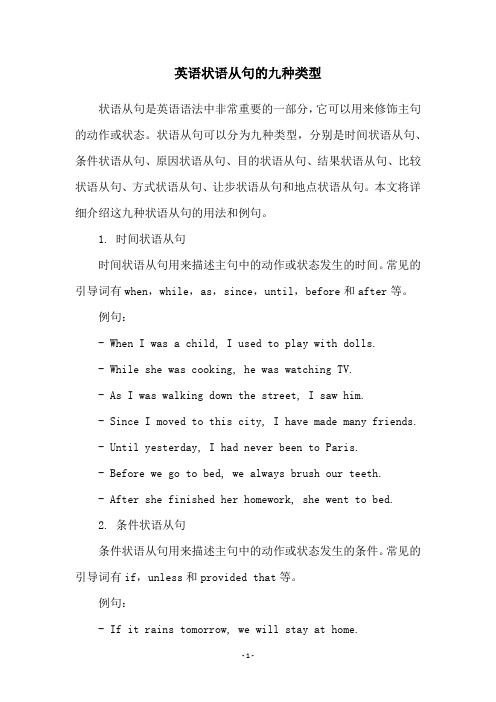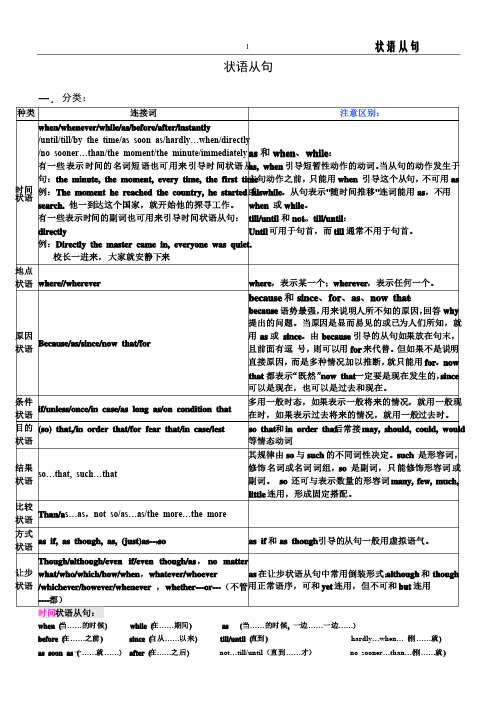状语从句(9种全)精编版
(完整版)状语从句知识点大全

(完整版)状语从句知识点大全状语从句是一个句子做另一个句子的状语,用于描述、限制、补充或解释主句的动作或状态。
在英语语法中,状语从句非常常见且广泛应用。
以下是状语从句的一些常见知识点:1. 时间状语从句(Time Adverbial Clauses):用来表示时间,常用的引导词有when, while, as, before, after, until, since等。
例如:I will call you when I arrive home.翻译:我到家时会打电话给你。
2. 地点状语从句(Place Adverbial Clauses):用来表示地点,常用的引导词有where, wherever等。
例如:She can't find her keys anywhere.翻译:她无论到哪儿都找不到她的钥匙。
3. 原因状语从句(Cause Adverbial Clauses):用来表示原因,常用的引导词有because, since, as, for等。
例如:I didn't go to the party because I was tired.翻译:因为我累了,所以我没有去参加聚会。
4. 结果状语从句(Result Adverbial Clauses):用来表示结果,常用的引导词有so, therefore, thus等。
例如:He studied hard, so he passed the exam.翻译:他努力研究,所以他通过了考试。
5. 条件状语从句(Condition Adverbial Clauses):用来表示条件,常用的引导词有if, unless, provided that等。
例如:If it rains tomorrow, we won't go to the park.翻译:如果明天下雨,我们不会去公园。
6. 目的状语从句(Purpose Adverbial Clauses):用来表示目的,常用的引导词有so that, in order that等。
英语中的九种状语从句

5、条件状语从句的引导词有if, if only(如果…… 就好了,但愿), unless, in case, as/so long as, provided that, providing that, suppose that, supposing that, on condition that , when。
(1)___the days went on, the weather got worse.
A. With
B. Since
C. While D. As
(2) ____the satellite launch drawing near,the research workers put their hearts to the test and always stayed up late.
状语从句
状语从句 (Adverbial Clause) 是指句子用作状 语,根据其作用可分为一下九种:
1. 时间状语从句 1) 引导词 ( 1 ) 表 示 “ 当 …… 时 候 ” : when, while, as,
whenever When I went into the room, he was at work.当我进屋
Even if I have to walk all the way I’ll get there. 即使我 得一路走着去,我也要走到那里。
• as引导的让步状语从句的结构是:名词(形 容词、副词、动词)+ as +主谓。如:
Child as he was, he knew what was the right thing to do. 尽管是个孩子,他知道要做的正确的事情 是什么。
状语从句(完整版)

since引导的时间状语从句
◆ since引导的时间状语从句,常译为“自从……‖, 主句常用现在完成时,从句常用一般过去时。 例句翻译:我们自从分手以后一直没见过面。 We haven’t seen each other since we parted. 常用句型:It has been (is) + 时间段 + since从句 “自从……有多长时间了 ” 例句翻译:自从她大学毕业已经有六年时间了。 It has been (is) six years since she graduated from the university.
7. 结果状语从句
8. 方式状语从句
9. 比较状语从句
引导词可分为两部分. as every time while next time when the first/…time whenever the moment before the minute/… after instantly until (till) immediately since directly (一…就…) as soon as
*将来情况-V一般现在时或现在进行时
e.g.— I’m going to the post office. -- While you are there, can you get some stamps for me?
*过去情况
e.g. I hurt my should while I was doing gym.
While 在句中的不同含义:
While I was walking down the street, I came when across an old friend. ( while=_______) While I really don’t like art, I find his work although impressive. ( while =_________ ) While there is life there is hope. as long as (while = __________ ) He likes pop music, while I am fond of folk music.
英语状语从句的九种类型

英语状语从句的九种类型状语从句是英语语法中非常重要的一部分,它可以用来修饰主句的动作或状态。
状语从句可以分为九种类型,分别是时间状语从句、条件状语从句、原因状语从句、目的状语从句、结果状语从句、比较状语从句、方式状语从句、让步状语从句和地点状语从句。
本文将详细介绍这九种状语从句的用法和例句。
1. 时间状语从句时间状语从句用来描述主句中的动作或状态发生的时间。
常见的引导词有when,while,as,since,until,before和after等。
例句:- When I was a child, I used to play with dolls.- While she was cooking, he was watching TV.- As I was walking down the street, I saw him.- Since I moved to this city, I have made many friends. - Until yesterday, I had never been to Paris.- Before we go to bed, we always brush our teeth.- After she finished her homework, she went to bed.2. 条件状语从句条件状语从句用来描述主句中的动作或状态发生的条件。
常见的引导词有if,unless和provided that等。
例句:- If it rains tomorrow, we will stay at home.- Unless you study hard, you will fail the exam.- Provided that you finish your work, you can go home.3. 原因状语从句原因状语从句用来描述主句中的动作或状态的原因。
(完整版)状语从句(完整归纳)

状语从句分类:when (当 .. 的时候)before (在 .. 之前)as soon as (一.. 就.while (在... 期间)since (自从... 以来))after (在 .... 之后)as (当……的时候,一边……一边……)till/until (直到)hardly …when…(刚就)not …till/until (直至U 才)no sooner …than ••刚就no matter+what/which/where/who/when =whatever/whichever/wherever/whoever/whenever(不论什么/哪一个/哪里/谁/何时)比较状语从句:as (正如) as …as (和- ... 一样)not as/so…as (不如… …)than (比… …更)the+比较级 …+the+比较级 (越……越……)条件状语从句:if (假设) unless (如果不) so long as (只要)on condition that (如果)方式状语从句: as (像 ... 那样地) just as (正像)as if (好像)as though(好像)各种状语从句的简化方法:1.以after 和before 引导的状语从句的主语若与主句主语一致时,从句等于after/before+doing sth.作状语。
例 After she sang , she left the rich man's house . = After singing , she left the rich man's house .2.以as soon as 引导的状语从句的主语若与主句主语一致时,从句等于 on+doing sth.,作状语,此时的动词为 非延续性动词。
例: Mary began to operate on the wounded soldiers as soon as he arrived at the village .=Mary began to operate on the wounded soldiers on arriving at the village .3. 时间状语从句和条件状语从句的主语和主句主语一致时,有时可简化为不定式作状语。
(完整版)状语从句(完整归纳),推荐文档

状语从句一.分类:when (当……的时候) while (在……期间) as (当……的时候, 一边……一边……)before (在……之前) since (自从……以来) till/until (直到) hardly…when… (刚……就) as soon as (一……就……)after (在……之后) not…till/until(直到……才)no sooner…than…(刚……就)地点状语从句:where (在那里) wherever(无论哪里)原因状语从句:because (因为) since (因为,既然) as (由于) for (为了) now that(既然)目的状语从句:(so)that=in order that(以便)so as (not)to (以便[不])in case(以免)lest(以免)结果状语从句:so+adj./adv.+that(如此……以致)so that(结果……)such+n.+that(如果……以致)that(所以,因此)让步状语从句:though/although不可同but连用。
though/although (虽然)however (可是)even though(即使)even if (即使)no matter+what/which/where/who/when =whatever/whichever/wherever/whoever/whenever(不论什么/哪一个/哪里/谁/何时)比较状语从句:as (正如)as…as(和……一样)not as/so … as (不如……)than(比……更)the+比较级…+the+比较级(越……越……)条件状语从句:if(假设)unless(如果不)so long as(只要)on condition that (如果)方式状语从句:as(像……那样地)just as(正像)as if(好像)as though(好像)二.各种状语从句的简化方法:1例:After she sang,she left the rich man's house.= After singing,she left the rich man's house.2.以as soon as引导的状语从句的主语若与主句主语一致时,从句等于on+doing sth.,作状语,此时的动词为非延续性动词。
英语状语从句的九种类型

英语状语从句的九种类型状语从句是英语语法中非常重要的一部分,它们能够为句子提供额外的信息以及更加丰富的语境。
状语从句可以用来描述时间、地点、原因、方式等等,根据不同的用途,状语从句可以分为九种类型。
本文将详细介绍这九种类型的状语从句,帮助大家更好地理解和运用它们。
一、时间状语从句时间状语从句用来描述一个事件发生的时间,常常使用连词when、while、as、before、after、since等。
例如:When I arrived at the station, the train had already left.(当我到达车站时,火车已经离开了。
)While I was cooking dinner, the phone rang.(当我在做晚饭的时候,电话响了。
)As soon as he saw me, he ran away.(他一看见我就跑了。
)Before you go to bed, don't forget to brush your teeth.(睡觉前别忘了刷牙。
)After I finished my homework, I went to bed.(我完成作业后就去睡觉了。
)Since he moved to the city, he has been very busy.(自从他搬到城市后,他一直很忙。
)二、地点状语从句地点状语从句用来描述一个事件发生的地点,常常使用连词where、wherever等。
例如:I will meet you where we agreed.(我会在我们约定的地方见你。
)Wherever you go, I will follow you.(无论你去哪里,我都会跟着你。
)三、原因状语从句原因状语从句用来描述一个事件发生的原因,常常使用连词because、since、as等。
例如:I didn't go to the party because I was sick.(我没去参加聚会是因为我生病了。
状语从句(完整归纳)

状语从句一.分类:种类连接词注意区别:时间状语when/whenever/while/as/before/after/instantly/until/till/by the time/as soon as/hardly…when/directly/no sooner…than/the moment/the minute/immediately有一些表示时间的名词短语也可用来引导时间状语从句:the minute, the moment, every time, the first time例:The moment he reached the country, he started hissearch. 他一到达这个国家,就开始他的探寻工作。
有一些表示时间的副词也可用来引导时间状语从句:directly例:Directly the master came in, everyone was quiet.校长一进来,大家就安静下来as和when、while:as, when 引导短暂性动作的动词。
当从句的动作发生于主句动作之前,只能用when 引导这个从句,不可用as或while。
从句表示"随时间推移"连词能用as,不用when 或while。
till/until和not…till/until:Until可用于句首,而till通常不用于句首。
地点状语where//wherever where,表示某一个;wherever,表示任何一个。
原因状语Because/as/since/now that/forbecause和since、for、as、now that:because语势最强,用来说明人所不知的原因,回答why提出的问题。
当原因是显而易见的或已为人们所知,就用as或since。
由because引导的从句如果放在句末,且前面有逗号,则可以用for来代替。
但如果不是说明直接原因,而是多种情况加以推断,就只能用for。
- 1、下载文档前请自行甄别文档内容的完整性,平台不提供额外的编辑、内容补充、找答案等附加服务。
- 2、"仅部分预览"的文档,不可在线预览部分如存在完整性等问题,可反馈申请退款(可完整预览的文档不适用该条件!)。
- 3、如文档侵犯您的权益,请联系客服反馈,我们会尽快为您处理(人工客服工作时间:9:00-18:30)。
状语从句在复合句中作状语的从句叫状语从句。
状语从句有时间、地点、原因、目的、结果、条件、方式、比较、让步等种类。
一、时间状语从句引导时间状语从句的连接词有: when, as, while, after, before, since, ever since, as soon as, once, till, until, whenever, no sooner…than, hardly/scarcely...when, themoment/minute/instant/second, every time, each time, any time, the first time, next time, last time, all the time, by the time, directly, immediately, instantly等。
1.表示“一···就···”的句型1) as soon as/onceAs soon as he arrives, I'll call you.他一到,我就给你打电话。
(as soon as 侧重时间或动作先后衔接紧,而once侧重条件,表示“一旦...”)2) on doing sth/on one's + n.作时间状语On arriving at the station, the thief was arrested.一到达车站,这个小偷就被逮捕了。
On his arrival in Paris, he was recognized as a noble and thrown into prison. 他一到达巴黎,就被认出是一个贵族,并被投入监狱。
3) no sooner ...than , hardly/scarcely...when它们表“一…就”。
结构中的否定词放在句首时,主句要倒装。
(主句都用过去完成时,从句用一般过去时。
)No sooner had he reached home than it began to rain.他刚到家,天就开始下雨了。
Hardly/Scarcely had I entered the room when the phone rang.我一进屋,电话就响了。
当no sooner, hardly, scarcely不放在句首时,主句不倒装,如:I had no sooner reached the bus stop than the bus started.我刚到车站,车就开走了。
I had scarcely(hardly)entered the room when the phone rang.4)the moment, the instant, the minute, the secondThe moment I saw him, I recognized him.我一看见他,就认出了他。
We'll leave the minute you are ready.你一准备好,我们就出发。
5)有些副词如:instantly, immediately, directly可用作连词,后接从句。
I left immediately the clock struck 5.我刚走,钟就敲了五点。
2. when, while, as引导时间状语从句1) when的用法①when既可指时间点,也可指时间段(即:从句动词可以是短暂的也可是延续的);主从句动作可同时也可先后发生。
I was thin when I was a child.当我是个孩子的时候,我很瘦。
It was raining when I arrived.我到达时,天正在下雨。
②在when引导时间状语从句时,如果从句主语与主句主语相同或为it,且从句有be动词,则从句可省主语和be动词,如:When (you are) in trouble, you can visit this man.当你有麻烦时,可以找这个人。
She is always listening to music when(she is) doing her homework. 当她做作业时,总是听音乐。
③when在下列结构中, 译成“这时”,它引导的是并列句be about to do ... when, be doing ... when, had done ···when,be on one's way ... when, be on the point of doing ... when(参见“连词”部分when的用法)2)while用法while只能指一段时间,从句中的动词必须是延续性动词。
强调某一段时间内发生主句动作,相当于during the time that....My mother was cooking while I was doing my homework.当我在做作业时,妈妈在做饭。
I am safe while I am here.我在这儿的时候,我很安全。
while除引导时间状语从句外,还引导对比句,作“然而”讲;并可在句首引出让步状语从句作“虽然···但”讲。
I like watching TV, while he likes reading.我喜欢看电视,而他喜欢读书。
While he has his own car, he often uses mine.尽管他自己有车,他却常用我的。
3) as的用法①as引导时间状语从句时常可和when换用,但较强调同时发生,多指短暂动作。
As I left the house, I forgot the key.我离家时,忘了带钥匙。
②as还可说明两种正在发展或变化的情况,“随着...”的意思,表时间的推移。
如:As I get older, I get more optimistic.随着年龄的增长,我变得更加乐观。
③as表“一边…一边…”,引出伴随动作。
He hurried home, looking behind as he went.他匆忙地回家,边走边往后看。
④用以强调两个动作紧接着发生。
As he was going out, it began to rain.当他出去的时候,天开始下雨了。
⑤as有时引出一个名词,相当于一个时间状语从句。
As a boy (when he was a boy), he was hopeless at maths.当他是孩子时,他对数学失去希望。
3. before引导的时间状语从句①before引导的时间状语从句不用否定式谓语。
Before they got to the bus stop, the bus had gone.在他们到达公共汽车站之前,公共汽车已经走了。
②在“It be + 时间段+ before从句”句型中,肯定句译成“…(之后)才”,否定句译成“…就”。
该句型有一般过去时、过去将来时、一般将来时三个时态,且有否定句。
It will be some time before... do...It was some time before...did...It would be some time before...did...It was long before...did...“很久才···”It wasn't long before...did...“不久就...”It will be many years before the chemicals start to escape fromthe containers. 多年以后化学物质才开始从容器中逃逸。
It was not long before he came back.不久他就回来了。
It was a long time before he got to sleep again.很久他才再次入睡。
It was a week before he could tell his story.一个星期后他才能讲述他的经历。
It wasn't long before he told us about himself.不久他就给我们讲述了他自己的故事。
▲before可译成“未来得及”He had measured me before I could get a word.我还未来得及插话,他就量好了尺寸。
▲before可译成“趁着还没”I'll write it down before I forget.趁着还没忘我要把它写下来。
4. until和till1)“延续性动词肯定式+until”表示“动作延续到…为止,”译为“直到…为止”,如:I waited for him until he came back. 我一直等到他回来。
2)“终止性动词的否定式+ until”表示“直到···才”。
He didn't go to bed until he had finished his work. 直到完成工作他才睡觉。
3)用于强调句式“It is not until ...that ...”It was not until the professor came that we began the experiment.在教授到来之后,我们才开始实验。
4) not until放在句首时,主句倒装。
Not until he graduated did he succeed in obtaining this compound. 直到他毕业他才成功获得这种化合物。
句首和强调句中要用until,而不用till;not...until...句型中不用till。
5. since引导时间状语从句,意为“自从…时起”,主句要用完成时。
Mr. Li has been here since he came back.自从李先生回来以后,他一直在这儿。
I haven't heard from him since he lived here.自从他住在这儿以来,我就没有收到过他的来信。
I've known Mr. Smith since I was a boy.我小的时候就认识史密斯先生了。
6.时间状语从句的省略式当时间状语从句的主语和主句主语相同或为it,从句又含be动词时,从句可省略主语和be动词。
在不产生歧义时,连词也可省去。
